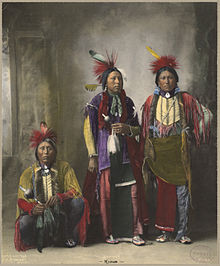The Real People: the Kiowa
The Kiowa were a powerful Native tribe who ranged throughout the southern Great Plains in search of the buffalo. Oral tradition places their origin near what is now Glacier National Park in Montana, just south of the border of Canada. They drifted southward down the Rocky Mountains into Colorado by the 17th and 18th centuries. Pressure from other tribes brought them to the southern plains by the 19th century. The Kiowa name for themselves translate to principal people or real people. During their time in Colorado, they shared land with the Arapahoe, who referred to them as the People by the River. Their language is part of the Kiowa-Tanoan language grouping and they were also proficient in the sign language used on the Plains.
Traditional Kiowa society is patrilineal. They were semi-nomadic hunters and gatherers, supplementing their diet by trade with more sedentary tribes who practiced agriculture. Like all the plains tribes, they were proficient in hunting and processing buffalo. They integrated the horse into their hunting and warfare, capable of protecting their range in what is now southeastern Colorado, western Kansas and the Red River area of Oklahoma and Texas. The Kiowa were divided into various bands rather than forming a centralized chiefdom. They were feared warriors and efficient raiders, noted for long-distance raiding. Enemies included Cheyenne, Navajo, Arapho, Ute and even Lakota, as well as the Pawnee, Osage, Kickapoo, Caddo, Sac and Fox, the Mescalero and Lipan Apache. Kiowa men who performed well in battle or on the hunt were invited to join elite warrior societies. The Kiowa were known for tracking time on buffalo skin calendars.
The Kiowa produced several great war leaders, including Touhasin, Big Tree, Satanta, and Satank, to name a few. They came into conflict with the Army in the 19th century, eventually moved to a reservation in Oklahoma. They are federally recognized as the Kiowa Tribe of Indians with headquarters in Carnegie, Oklahoma. Many are still able to speak their traditional language.
Traditional Kiowa society is patrilineal. They were semi-nomadic hunters and gatherers, supplementing their diet by trade with more sedentary tribes who practiced agriculture. Like all the plains tribes, they were proficient in hunting and processing buffalo. They integrated the horse into their hunting and warfare, capable of protecting their range in what is now southeastern Colorado, western Kansas and the Red River area of Oklahoma and Texas. The Kiowa were divided into various bands rather than forming a centralized chiefdom. They were feared warriors and efficient raiders, noted for long-distance raiding. Enemies included Cheyenne, Navajo, Arapho, Ute and even Lakota, as well as the Pawnee, Osage, Kickapoo, Caddo, Sac and Fox, the Mescalero and Lipan Apache. Kiowa men who performed well in battle or on the hunt were invited to join elite warrior societies. The Kiowa were known for tracking time on buffalo skin calendars.
The Kiowa produced several great war leaders, including Touhasin, Big Tree, Satanta, and Satank, to name a few. They came into conflict with the Army in the 19th century, eventually moved to a reservation in Oklahoma. They are federally recognized as the Kiowa Tribe of Indians with headquarters in Carnegie, Oklahoma. Many are still able to speak their traditional language.




Comments
Post a Comment